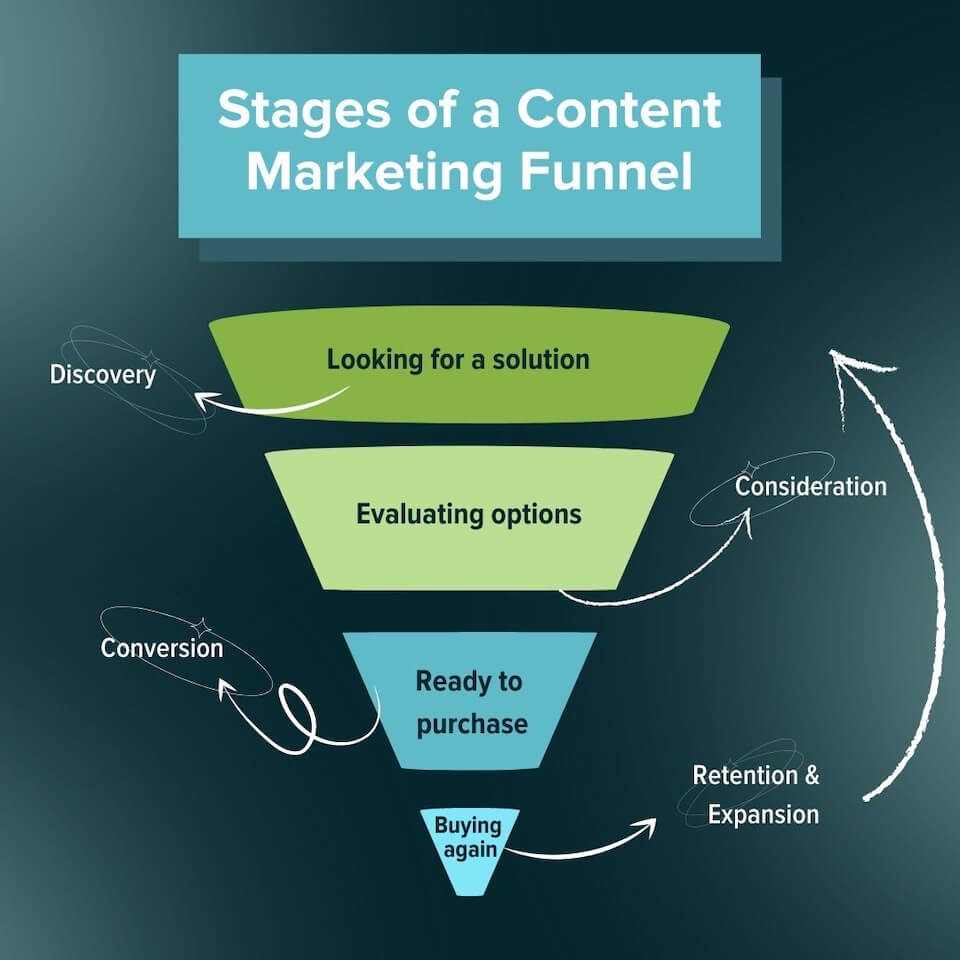
How to Create a Top-Performing Content Marketing Funnel
Apr 21, 2022|Read time: 15 min.
Key Points
- A content marketing funnel is a tool that helps you organize your content around the phases of the marketing funnel.
- Creating a content marketing funnel allows you to build value-based relationships with potential customers.
- Content funnels improve your marketing efforts from awareness through retention.
Have you ever tried to buy a coffee maker in a retail store? It’s a painful experience. You stare at box after box trying to figure out which features you need while wondering which contraption brews the best cup of joe for your buck. The experience is the same for any other household appliance, including washers, dryers, refrigerators, you name it.
Why? Because retail stores don’t have content marketing funnels.
Consumers can’t make informed purchases at the bottom of the funnel if they don’t get the information they need at the top of the funnel first.
Ultimately, if you control the information at the top of the content marketing funnel then you control the sale. Here’s how.
What is a content marketing funnel?
Marketing term
Content Marketing Funnel
A content marketing funnel is a tool that helps you organize your content around the phases of the marketing funnel. The goal is to align your content with audience needs and expectations at each stage of the buying journey.
The funnel contains four different stages: TOFU, MOFU, BOFU, and retention. We can map each of these phases to a specific segment of a buyer’s journey:

- Discovery: At the top of the funnel (TOFU), prospects become aware of their problem or desire, search for a solution, and discover your brand.
- Consideration: At the middle of the funnel (MOFU), prospects evaluate options and consider whether your product or service fits their needs.
- Conversion: At the bottom of the funnel (BOFU), prospects make a purchase decision and become customers.
- Retention and Expansion: After the sale, customers may buy again, or explore related products and services.
At each stage, we use different types of content marketing formats to move prospects further down the funnel.
For example, TOFU content creation might include informational blog posts that target discovery-stage keywords. MOFU content could include e-books, webinars, or buying guides that provide more in-depth information about your product. And BOFU content might include free trials, demos, or discounts to entice prospects to make a purchase.
The value of creating a content marketing funnel
Content marketing funnels are important because they increase customer value, strengthen customer relationships, fill content gaps, increase conversions, and improve retention. By creating content that’s tailored to each stage of the customer journey, you can address audience needs more effectively.
A content funnel can reveal areas where you underserve your audience. For example, you may have plenty of case studies and testimonials, but you might lack informational content that’s fueled by investments in search engine optimization (SEO).
Additionally, a content marketing funnel allows you to measure key metrics separately for each phase of the buying journey. By analyzing the performance of each piece of content and groups of content in each stage, you can more effectively optimize your conversion funnel.
Finally, by leveraging retention-focused content marketing, you can improve key business metrics like customer lifetime value (CLV) and customer acquisition cost (CAC). As a result, you’ll drive greater overall marketing ROI.
Content Strategy Playbook
The Fortune 500 CMO’s guide to content strategy.
Content marketing funnel stages
Let’s take a closer look at each stage of the content marketing funnel.
Discovery
The first stage in a content marketing funnel is the discovery stage (or awareness stage). In this phase, prospects are aware of their problem or desire, but they aren’t seeking solutions yet. Instead, they want to learn more about the problem and understand the causes, impacts, and next steps.
The goal at this stage of the sales funnel is to build relationships with prospects.
A discovery-stage content marketing strategy must clearly address your audience’s pain points and help prospects fully understand their challenge.
Take off your sales hat or you may scare away potential customers who aren’t ready to buy yet. Instead, use content strategically to move prospects into the consideration phase of the content marketing funnel.
Consideration
In the consideration stage, prospects research different types of solutions and companies and they start to build a list. Although they may explore product categories and specific brands, they probably aren’t ready to purchase yet. In this stage, prospects want more in-depth information about their options.
Content in this stage should help your audience compare options and highlight your expertise and authority in your industry. Clarify what separates you from the competition and demonstrate why your solution is the best possible option. Some excellent content formats to boost your credibility include testimonials, case studies, or use cases.
Try not to push for the sale in the consideration stage. Instead, clarify your value proposition and guide potential customers to the conversion stage.
Conversion
Finally, in the conversion stage you can push for the purchase. Prospects are now well-informed about their problem as well as specific solutions. They probably narrowed down their choices to two or three options.
Content in this stage should reinforce your value, reduce risk, and push prospects toward a purchase. This is the stage where coupons, free trials, discounts, or other incentives can get prospects to take the next step. It’s also a great place to showcase your refund policy and customer service.
If you did your job in the discovery and consideration stages, it should be easy to convince prospects to choose your brand. The opposite is also true. Low-quality content in the first two stages makes it extremely difficult to convince prospects to buy from you.
Retention and Expansion
The content marketing funnel doesn’t end when a new customer makes a purchase. Retention marketing is all about analyzing and extending the customer lifecycle to increase CLV. This might include getting existing customers to buy the same products again, or introducing them to other products and services you offer.
Content in this phase includes email marketing, newsletters, retargeting ads, direct mail, loyalty programs, and exclusive deals.
It costs five times more to sell to new customers than existing ones. Furthermore, by introducing current customers to more of your products, you draw them deeper into your ecosystem and amplify brand loyalty.
Make Connections that Matter
Uncover what your customers are looking for in real time and meet their needs with valuable content.
How to target each stage of the content marketing funnel
Let’s dive into all the different ways your content strategy can target users throughout the funnel.
Discovery stage of the content marketing funnel
In the discovery stage, your primary objective is to create content types that build brand awareness for potential customers.
Ads
Ads are an easy way to reach your target audience. Social media ads allow you to customize your audience, messaging, and visuals. Paid search ads, on the other hand, let you target keywords your audience searches. Finally, retargeting ads are an excellent way to reach folks who already visited your website.
There are some advantages and disadvantages to paid advertising. For example, ads have a higher customer acquisition cost than organic search. Furthermore, audience segmentation data is unreliable. With the death of third-party cookies on the horizon, tracking data will be even more limited.
Blog posts
Blog posts are an excellent way to connect with prospects in the discovery stage. This type of long-form content should target problem-oriented keywords and answer questions such as what and why.
It’s important to do keyword research so you understand how your audience thinks about their problems. They may use many different phrases and long-tail keywords as they learn about the underlying causes of their issue and whether or not to act.
When you develop your blogging strategy, think about how you will guide users through the content marketing funnel.
Educational content
Educational content is perfectly suited to the awareness stage because it clarifies customer pain points and introduces next steps.
Educational content should be digestible and concise to help prospects understand a particular topic.
This type of content includes:
- Videos
- Courses
- Podcasts
- Slide decks
- Templates
- Worksheets
Social media posts
Billions of people use social media every day, so it’s an excellent way to connect with a broad audience in the discovery stage. However, there are two distinct challenges when it comes to using social media.
First, you need to know which platform(s) your target audience uses. Do they use Facebook? LinkedIn? Instagram? TikTok? Conduct audience research to uncover where your target audience spends their time online.
Second, if you want serious engagement from your social media content, you need to pay up. Social networks have significantly reduced organic brand visibility to push companies into their paid advertising programs. To gain traction organically, you’ll need to know which types of posts generate the most engagement on each platform.
That said, social media should certainly be part of your content marketing funnel.
Infographics
Infographics are a great way to capture attention and quickly convey complex information. Visual content can reach new audiences that prefer images over text. It also works well on social media networks like Pinterest and Instagram.
The most effective infographics have a clean, simple design and explain a single topic. If you pack too much into your infographic it will overwhelm your audience. Avoid jargon or insider language and keep it simple without being reductionist.
Podcasts
According to Convince & Convert, 80 million Americans listen to podcasts each week. That means they can be an effective way to connect with prospects at the top of your content marketing funnel who don’t know they have a problem yet.
0
Million80 million Americans listen to podcasts each week
–Convince & ConvertBefore starting a podcast, make sure to invest in the necessary equipment. For many audiences, your audio doesn’t need to be studio quality, but it should sound professional.
Also, take time to research the top podcasts in your vertical. Who is the target audience? How long are they? What subjects do they cover? To attract listeners, you need to be able to provide value in a way that other podcasts don’t. You could differentiate yourself by subject matter, length, presentation style, insider knowledge, and many other things.
How-to videos or guides
Video content is a great way to connect with prospects, build trust, and establish authority. How-to videos in particular can be highly effective in the consideration stage because they offer solutions to common problems.
For example, if you sell cloud-based accounting software for freelancers, you could create step-by-step guides to maximize deductions, get paid faster, etc.
Ebooks
Ebooks are one of the most versatile pieces of content you can create. You can use them at any stage in the funnel, from discovery to purchase. Furthermore, you can repurpose them into other types of content like blog posts or social media posts.
Shorter e-books are excellent lead generation tools in the discovery stage. A single landing page can generate a significant number of leads by asking prospects to provide their email address in exchange for the e-book.
Checklists
Checklists are a great way to provide value, especially if they can be downloaded and printed. They’re particularly effective since they’re usually about a broad subject that someone in the discovery stage would be searching for.
For example, if sell mortgages, a “Mortgage Closing Checklist” would both provide value to prospects and introduce them to your brand. As an added bonus, you could use it as a lead magnet to draw prospects into your funnel.

Consideration stage of the content marketing funnel
In the consideration stage, your goal is to further educate prospects about the nature of their problem or goal, while also slowly introducing them to your brand. There are various types of content that can help you achieve this.
Case studies
Case studies are in-depth looks at how a customer or client was able to solve a problem with your product or service. They give prospects additional insight into the nature of their problem, while also introducing your brand and showing how you helped someone in a similar situation.
To create an effective case study, select a customer or client who is willing to participate. Interview them about their problem, how they found your brand, and the results they achieved with your product or service. Finally, write up the case study in an engaging way and include any relevant quotes, data, or statistics.
In the consideration stage, prospects are actively comparing different solutions to their problem. Case studies allow you to demonstrate why your solution is superior. You can explore Terakeet’s case study page here.
Webinars
Webinars allow you to provide high-value information to prospects in much more depth than you can through a blog post or ebook. They also give you an opportunity to establish your brand and build trust with prospects. Live webinars are particularly effective in helping you establish a rapport with prospects since they allow you to answer questions in real-time.
While there is no hard and fast rule, many webinars are between 30 – 60 minutes. This gives you enough time to present enough information to make the webinar valuable, while not taking up too much time.
White papers
White papers can be a valuable asset to give to prospects in the consideration/education stage of the marketing funnel. They’re similar to blog posts and e-books. White papers provide in-depth information about a particular topic, but they’re shorter and easier to digest than an e-book. They also tend to be more technical than other types of content marketing efforts, with many relevant statistics, data points, and research.
White papers help you demonstrate your knowledge, expertise, and authority to prospects. They also help you educate prospects in significant detail regarding the nature of their problem and how your brand can help solve it.
Here’s an example of one of Terakeet’s white papers:
Value of Organic Search White Paper
See how an investment in organic search delivers ROI that compounds over time.
Emails
Despite being around for decades, email marketing still remains an effective tactic for reaching prospects at every stage of the funnel. Emails allow you to connect on one-to-many level with prospects in the consideration stage of the funnel and help you deepen relationships.
Emails at this stage can take a number of different formats:
- Links to valuable resources
- Encouraging prospects to ask questions
- Addressing common audience problems or frustrations
- Inviting prospects to a live event, such as a webinar or live stream
- Quick check-ins
- And more…
As you craft email sequences for this stage of the funnel, try to determine what prospects need most. Let the needs of prospects shape your email newsletter topics and follow up.
Expert guides
In the last 5 – 7 years, expert guides have become a staple of content marketing. Essentially, they are very long blog posts that thoroughly cover a topic from top to bottom. For example, our expert guide on content marketing for executives goes very deep on the value of content marketing and why executives should prioritize it.
There are two significant advantages to creating expert guides. First, they are an excellent way to demonstrate your deep knowledge and expertise on a particular topic. This helps you build trust with prospects. They know that if they work with you, they will be working with an expert.
Expert guides are also great for SEO. In most cases, expert guides tend to rank much higher in search results than shorter, less thorough content. By providing in-depth, valuable information on a particular topic, you can position your website as an authority on that topic.
Expert guides also tend to receive many more backlinks than less authoritative content. This boosts the domain rating of both your website and specific pages. A strong domain and backlink profile almost always translate into higher search rankings.
Comparison articles
Comparison articles have become increasingly popular in recent years due to constantly growing choices available to us. These articles compare two or more similar products or services, helping prospects understand the features and benefits of each option.
Creating these articles allows you to place your product or service side-by-side with your competitors. As prospects read the comparison, they can see the specific ways your product or service is different and better. This type of content can be very effective in the decision stage as well, since it helps prospects understand why they should choose you over your competitors.
Forrester Study White Paper
See how fully integrated SEO drives business impact across the enterprise.
Conversion stage of the content marketing funnel
By the time prospects get to the conversion stage, they should already have a very good understanding of your brand. They may also have deep insight into how your product or service works and how it can help them. They should also trust you as a vendor. If they don’t, they likely won’t convert.
At this stage, content is primarily used to give qualified leads the nudge they need to get them to take action.
Free trial or sample
Though this marketing strategy has been around for years, it’s still an effective way to convert prospects to customers. Free trials are particularly useful if your product has a relatively high cost. They allow prospects to experience the benefits of your product before making a financial commitment.
Free samples function the same way. Prospects get a small taste of the benefits they’ll receive from your product without having to pay money up front.
One caveat regarding free trials. If prospects are automatically charged after their free trial is over, you need to make this abundantly clear. Nothing turns off prospects more than being charged for something they don’t want.
Coupons and discounts
Coupons and discounts are another classic way to boost conversion rates. They give prospects a financial incentive to make a purchase. Coupons can come in the form of a simple monetary discount or as bonus features for free.
Ideally, you should only offer coupons to prospects who are on the fence about making a purchase.
They can be very effective at getting prospects to take action, but you need to use them carefully.
If you offer too many coupons or discounts, you may attract price-sensitive buyers who will never pay full price for your product. This can quickly eat into your profits and cause your business to become unsustainable.
Ideally, you should only offer coupons to prospects who are on the fence about making a purchase. This could be their first purchase from you or they may be considering one of your competitors.
Free consultation
If your product or service is somewhat complex, you may want to offer a free consultation. This allows you to have a conversation with the prospect to see if your product is a good fit.
When offering consultations make sure the prospect is aware of all that will be involved . Will there be a sales pitch at the end? How long will it last? What information should they have on hand. Making these things clear prevents miscommunication and prospects feeling frustrated.
What to do after the content marketing funnel
After prospects pass through the content marketing funnel, they will be in one of several categories:
- Customer – The prospect was persuaded to purchase and is now a customer. In this case, retention is the primary goal. You want to provide outstanding service to your customers so they continue doing business with you and send referrals to you.
- Engaged prospect – The prospect wasn’t quite ready to purchase but is still interested in your product/service. They may be actively engaged, such as subscribing to your email list or downloading additional content. In this case, the goal is to keep the prospect engaged until they’re ready to purchase.
- Unengaged prospect – The prospect showed some interest at one point but has since gone cold. They may have unsubscribed from your email list or stopped visiting your website. In this case, the goal is to re-engage these prospects. To that end, you may want to grab their attention again through captivating content that cuts through all the noise.
- Not a fit – These prospects simply aren’t a good fit for your company. Unless something significant changes, no further action is needed.
Go beyond content
As you cast your digital marketing net to haul in more customers, you need to think in terms of quality, value, and intent. When your audience is online, they’re actively engaged, but they’re also really good at ignoring noise. And there’s an incredible amount of noise.
If you want to apply attraction marketing to win prospective customers, convert them into paying customers, and keep them coming back again and again, build a content marketing funnel.
The Brand Intelligence Report
Exclusive AI insights, search trends, and brand strategies, delivered to your inbox.




